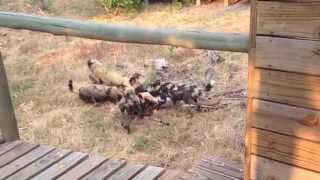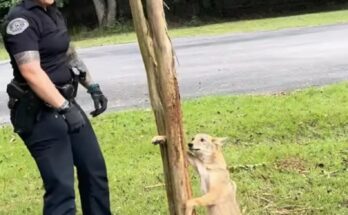
In the heart of Africa’s wilderness, where life and death coexist in constant balance, a recent wildlife encounter has stirred both fascination and discomfort among onlookers. A pack of African wild dogs—also known as painted wolves—was filmed in the midst of a successful hunt, taking down their prey in a scene both powerful and deeply unsettling. The rawness of the moment reminded many that in nature, survival is often harsh, swift, and unforgiving.
The incident occurred during a morning safari in one of southern Africa’s renowned reserves. Tourists, eager to spot the elusive wild dogs, were thrilled when guides picked up their fresh tracks. These predators are among Africa’s most efficient hunters, known for their teamwork and relentless stamina. However, few were prepared for what they were about to witness.
The pack, consisting of around a dozen dogs, had locked onto a young impala grazing alone near a clearing. At first, the scene appeared calm, the impala unaware of the danger closing in. Then, as if signaled by instinct, the pack spread out, circling their target in perfect coordination. Within seconds, the quiet morning erupted into chaos—barking, dust, and speed blending into a blur of motion.
Wild dogs rely on endurance rather than stealth. Unlike lions or leopards that rely on ambush, wild dogs chase their prey over long distances until exhaustion sets in. The impala ran for its life, darting through the bush and leaping over scrub, but the dogs’ teamwork proved unstoppable. One by one, they closed in, cutting off escape routes and nipping at its legs. The hunt was fast, brutal, and efficient.
For the onlookers, the sight was difficult to watch. Cameras that moments earlier captured excitement now recorded the harshness of survival. Guides explained that such scenes, while distressing, are a natural part of the ecosystem. Every kill sustains not only the pack but also ensures balance within the environment.
African wild dogs are among the continent’s most endangered predators, with fewer than 7,000 remaining in the wild. Habitat loss, disease, and conflict with humans have pushed them to the brink. Their survival depends on their exceptional hunting strategy, which relies on cooperation and communication. Each member of the pack plays a vital role—some chase, others block, and a few stay back to protect the young. Their success rate in hunting can reach as high as 80%, one of the highest of any predator.
After the chase ended, the pack fed quickly and efficiently. They tore off pieces of meat to carry back to pups hidden in a nearby den—a behavior unique among many carnivores. Within minutes, the chaos subsided, and the bush fell silent once again. What moments before seemed violent was, in truth, a cycle as old as the land itself.
Tourists and guides later reflected on the experience with mixed emotions. Some described feeling shaken, others awed. “It’s hard to watch, but it’s nature,” one visitor said softly. “You realize everything out here fights to live. It’s not cruelty—it’s survival.”
Conservationists emphasize that such encounters are essential to understanding the natural order. While human emotions often view predation as cruel, it is an integral process that keeps herbivore populations healthy and ecosystems in balance. Without predators like wild dogs, the delicate web of life in the savanna could collapse.
The moment serves as a powerful reminder that nature does not follow human rules of mercy or morality. It operates on instinct and equilibrium—where every life taken ensures others endure. As the sun set over the savanna, the pack rested in the tall grass, their bellies full and their pups waiting nearby. In their world, every hunt tells a story—not of brutality, but of resilience, adaptation, and the eternal rhythm of survival.
WATCH VIDEO ➡️


